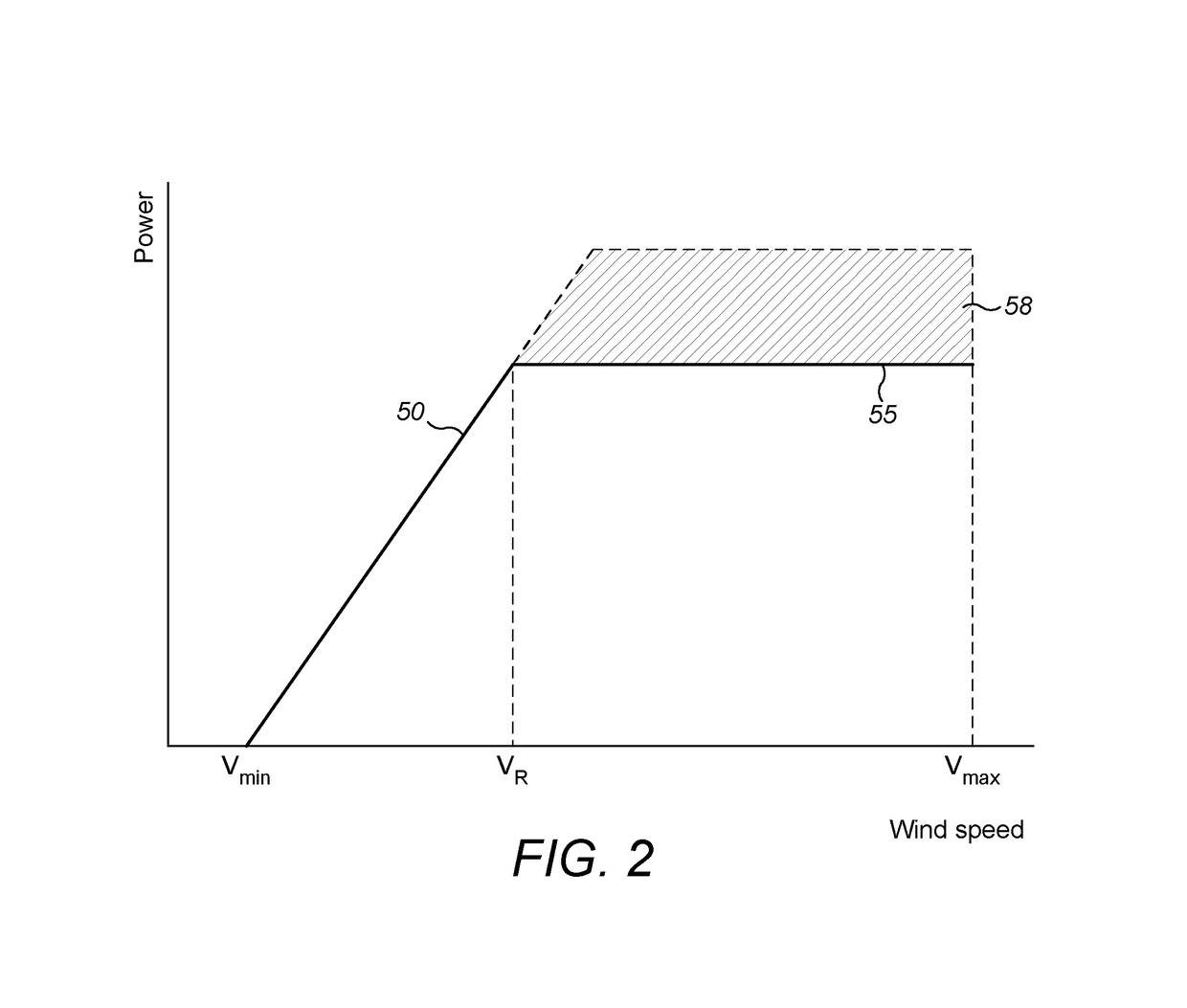Turbine over-rating using turbulence prediction
a technology of turbine overrating and turbulence, which is applied in the direction of optimizing machine performance, engine fuction, energy industry, etc., can solve the problems of increased maintenance, damage to the wind turbine, and dangerous overrating, so as to reduce the extent, increase the annual energy production, and avoid potential damage to the turbine
- Summary
- Abstract
- Description
- Claims
- Application Information
AI Technical Summary
Benefits of technology
Problems solved by technology
Method used
Image
Examples
first embodiment
[0064]The tower clearance does not take into account the weather conditions at the wind turbine, and so has to be configured to allow for the possibility of an extreme gust occurring at the wind turbine. This means that the tower clearance is configured to be greater than is necessary for normal operation of the wind turbine, and as a result the pitch control is unduly constrained during normal operation. In a first embodiment, therefore the controller allows a smaller tower clearance for the wind turbine blades, when the weather information does not indicate turbulent conditions. This can be achieved by adjusting the thrust reference FT-ref 502 shown in FIG. 5 to a higher value during a period of over-rating, corresponding to a smaller tower clearance. If turbulent conditions are again indicated by the weather information, the controller cancels over-rating, and the thrust reference FT-ref 502 reverts to a more conservative value.
second embodiment
[0065]Similarly, FIGS. 6 and 7 show the thrust curves and the associated pitch control curves for an over-rated mode of operation 600 and 700 and a more conservative 602 and 702 or non-over-rated mode of operation. As before, in the second embodiment, the wind turbine controller switches between the two modes of operation based on the weather information. If the weather information indicates that weather and wind conditions are safe, that is no turbulence or extreme gusts are predicted, the controller operates the wind turbine according to the pitch control curve 702. If the weather information indicates that turbulence or extreme wind gusts are expected, then the controller switches to the conservative mode 700 of operation. The associated thrust experienced by the blades is shown in FIG. 6.
[0066]FIG. 6 assumes that a thrust limiter operation is not applied or is not required. The thrust limiter operation of FIGS. 4 and 5 may however also operate in conjunction with the control of ...
third embodiment
[0072]In the invention, over-rating of the rotational speed ωg of the generator is carried out based on the weather information. The rotational speed of the generator is typically measured in revolutions per minute (R.P.M.) over time, and with relation to a shutdown threshold. Above the cut-in wind speed vmin (see FIG. 2), the wind turbine controller 38 gradually ramps up the generator speed ωg with increasing wind speed until the maximum rated generator speed is reached. This occurs just before the rated wind speed. As the generator speed is being ramped up, the turbine can be controlled to have an optimum tip speed ratio for the incident wind, and the generator speed follows the wind speed in an approximately linear relationship. Such control can be obtained by varying the pitch of the blades for example. The wind turbine extracts the maximum power from the wind as the controller provides optimal pitch and power references, but produces a power output that is below the rated power...
PUM
 Login to View More
Login to View More Abstract
Description
Claims
Application Information
 Login to View More
Login to View More - R&D
- Intellectual Property
- Life Sciences
- Materials
- Tech Scout
- Unparalleled Data Quality
- Higher Quality Content
- 60% Fewer Hallucinations
Browse by: Latest US Patents, China's latest patents, Technical Efficacy Thesaurus, Application Domain, Technology Topic, Popular Technical Reports.
© 2025 PatSnap. All rights reserved.Legal|Privacy policy|Modern Slavery Act Transparency Statement|Sitemap|About US| Contact US: help@patsnap.com



